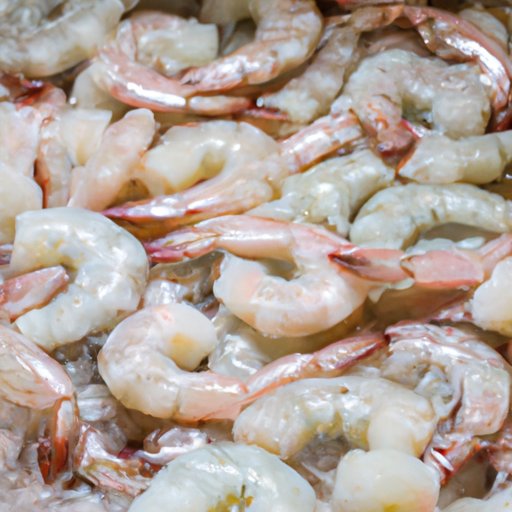
Introduction
Shrimp is a delicious and versatile seafood that can be used in a wide variety of dishes. However, it’s important to properly thaw shrimp before cooking it to ensure that it’s safe to eat and that it cooks evenly. In this article, we’ll explore the best methods for thawing shrimp, including some quick and easy alternatives, and offer tips for ensuring food safety when working with shrimp. We’ll also provide some creative recipe ideas using thawed shrimp, tips for choosing the right thawing method depending on the situation, and some unexpected DIY methods for when conventional thawing isn’t an option.
The “why” and “how” of thawing shrimp
Before delving into the specific thawing methods, it’s important to understand why properly thawing shrimp is so crucial. If shrimp is not thawed correctly, it can lead to foodborne illness, uneven cooking, and an unpleasant texture. To thaw shrimp safely, there are a few key methods that work best. One of the most common is the fridge method, which involves placing the shrimp in the fridge overnight to thaw slowly. Another popular option is using cold water to thaw shrimp quickly, while the microwave can be used in a pinch.
When using the fridge method, it’s important to plan ahead and keep the shrimp sealed tightly in a plastic bag or container to prevent any bacteria from contaminating it. Cold water thawing involves placing the shrimp in a sealed plastic bag and submerging it in cold water, changing the water every 30 minutes until the shrimp is fully thawed. In the microwave, it’s important to use the defrost setting and to check the shrimp regularly to ensure it doesn’t begin to cook.
To determine how long it will take to thaw shrimp using these methods, take into account the thickness of the shrimp, as thicker shrimp will take longer to thaw. As a general rule, it’s best to allow 12 to 24 hours to thaw shrimp fully in the fridge, depending on the quantity, and to allot for about 30 minutes per pound of shrimp for cold water thawing.
Quick thawing methods
If you’re short on time and need to thaw shrimp quickly, there are other options to consider. One of the most popular is thawing shrimp under cool running water, which is safe and effective as long as you submerge the shrimp in a sealed plastic bag and monitor it closely to avoid contamination. The microwave can also be used for quick thawing, but it’s important to keep an eye on the shrimp to ensure that it doesn’t begin to cook.
Safety tips for thawing shrimp
When handling and thawing shrimp, it’s crucial to practice proper food safety to avoid the risk of illness. This includes washing your hands frequently, using separate cutting boards to avoid cross-contamination, and following basic food safety guidelines, such as cooking shrimp to an internal temperature of 145 degrees Fahrenheit.
It’s also important to handle and store thawed shrimp properly to avoid any risk of bacterial growth. Shrimp that is thawed in the fridge can be stored for up to two days, while shrimp thawed under cold water should be cooked right away. If shrimp smells off or has slime or discoloration, it should be thrown out immediately to avoid the risk of foodborne illness.
Creative recipe ideas using frozen shrimp
Frozen shrimp can be an incredibly versatile ingredient for quick and easy meals, and there are endless recipe ideas to try. One easy option is to sauté the shrimp in olive oil with garlic and lemon for a delicious and simple dinner. Another idea is to grill shrimp on skewers with vegetables for a healthy and flavorful meal. For a more complex dish, try shrimp scampi or coconut shrimp curry. There are also endless possibilities for shrimp-based salads, pastas, and tacos.
Pros and cons of different thawing methods
While the fridge method is generally the most reliable method for thawing shrimp, there are benefits and drawbacks to each technique. For example, cold water thawing is quicker than using the fridge, but it requires more attention and can lead to bacterial growth if not done carefully. The microwave can be a quick option, but it also requires close attention and can lead to uneven cooking if not done correctly. Overall, the best method to use will depend on your specific situation and needs.
Shrimp DIY
If conventional thawing methods are not available, there are some DIY techniques that can do the trick. One option is to thaw shrimp in a brine solution with salt and sugar, while another is to vacuum-seal the shrimp in a plastic bag and immerse it in cold water. These methods can be effective, but they also require careful monitoring and are not always as reliable as conventional methods.
Conclusion
Thawing shrimp may seem like a simple task, but it’s important to do it correctly to ensure that the shrimp is safe to eat and that it cooks evenly. By following the guidelines outlined in this article, you can ensure that your shrimp is always perfectly thawed and ready to use. So whether you’re cooking shrimp for a weeknight dinner or preparing for a special occasion, take the time to thaw it properly for optimal results and food safety.





